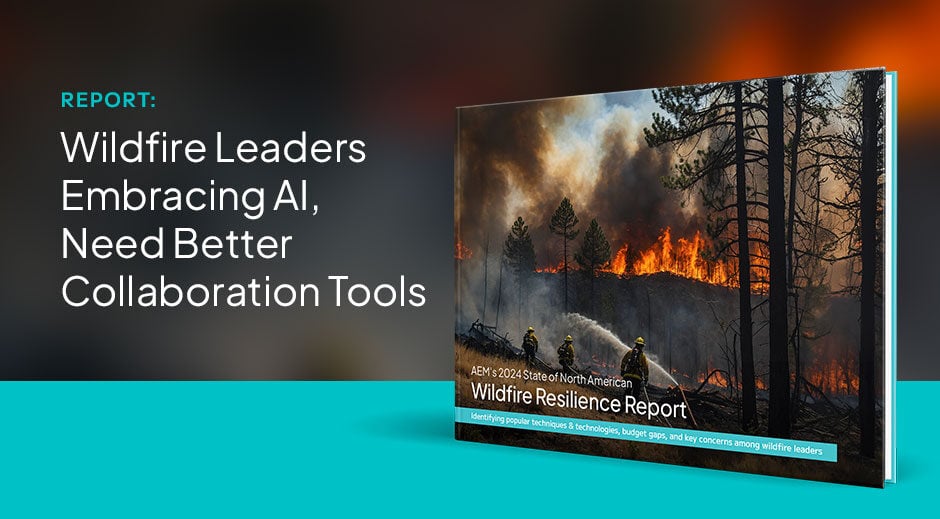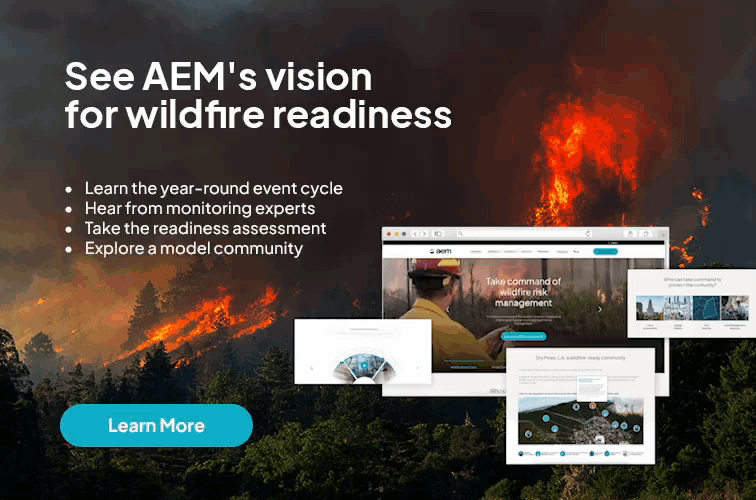
This spring, we surveyed more than 170 public sector wildfire leaders across North America to benchmark the state of the industry, identify growing tools and techniques, and get inside the heads of those at the frontlines of the growing battle against major fires.
The data we gathered indicates that, while teams across the U.S. and Canada uniformly agree about the importance of the challenge, inconsistent funding and a lack of clarity around how to assess and integrate new technologies are holding back their ability to rise to the occasion.
Moving forward, we’ll…
- Present a few key takeaways from our 2024 Wildfire Resilience Report
- Explore the biggest gaps and needs identified by the report
Key North American wildfire statistics for 2024
When we surveyed chiefs, captains, and commanders in the wildland fire service along with emergency response coordinators and other local leaders, we wanted to understand what approaches and tools they use to manage wildfire risk. Here were some of our big takeaways...
Wildfire weather risk monitoring is king
A whopping 91% of wildfire teams across North America report using weather stations or data from a weather station network as part of their strategy. That number speaks to the success of organizations like the National Interagency Fire Center and Canadian Interagency Forest Fire Centre, who work tirelessly to provide wildfire leaders with reliable weather intelligence.
More than half (51%) of respondents also indicate that they utilize portable or quick-deploy wildfire weather stations to provide additional tactical data during fire responses and planned activities, such as prescribed burns. That number is likely to increase in the next year or so, thanks to our next finding...
Prescribed burns are growing as a fire prevention tactic
Our report uncovered that federal and state-level agencies are most likely to be in charge of coordinating controlled burns, although more than a third of county wildfire organizations participate in fuel management programs as well.
 Local teams represented the only segment of the response group with a reduction of prescribed burning, but at every other level of the fire service, planned burns are a growing practice. The buy-in at the state and federal levels shows that these land management techniques are here to stay, not a fad that's going to blow over with the next big fire.
Local teams represented the only segment of the response group with a reduction of prescribed burning, but at every other level of the fire service, planned burns are a growing practice. The buy-in at the state and federal levels shows that these land management techniques are here to stay, not a fad that's going to blow over with the next big fire.
Speaking of tools that are here to stay, let's talk about the third major trend our report quantified: AI adoption.
AI smoke detection emerging as a powerful tool for wildfire teams
More than one-in-five of our survey respondents (21%) indicated that their team is using AI-supported smoke detection cameras as part of their wildfire risk management strategy. With AI, wildfire teams can automate fire monitoring until a camera notices a potential ignition, alerting a human professional to review and assess the data.
This finding reflects the rapid growth of visual AI and means there's a robust community of "early adopters" who are building a value case for the other 79% through successful detections and mitigations. It's also crucial that those early AI adopters work closely with solution providers to refine and improve the technology so it's as powerful as possible for them and their peers.
In the full version of the 2024 Wildfire Resilience Report, we provide a full profile of the typical wildfire risk management toolkit for teams across North America. We uncovered a variety of insights into adoption rates and usage for new tools, including...
- What different kinds of cameras are wildfire teams using?
- How many wildfire organizations leverage fuel and soil moisture sensors?
- How commonplace is lightning detection in the wildfire space?
What do wildland firefighters need in order to do better?
While our survey provided a lot of good news about the growth of wildfire risk management technologies and whole-cycle thinking about fires, we also uncovered some reasons for concern. Here are the three biggest needs we identified across the North American wildfire community:
Improved interagency collaboration
When we asked wildfire leaders to map their budgets against the event cycle of prevention/preparedness, detection/response, and recovery/rehabilitation, we uncovered that almost no teams are funded to address the entire challenge.
Some teams have robust funding to fight fires but have no hand in what happens before or after the event. Others are funded for prevention or recovery but lack the local knowledge of the firefighting teams who actually live in affected communities or tackled the flames firsthand.
To meaningfully improve outcomes and protect people, infrastructure, and economies from the growing threat of fires, wildfire teams at every level of government and even in the private sector must rally together to combine budget, expertise, and intelligence. We call this "collaborative resilience," and it's a big part of our vision for wildfire readiness at AEM.
Function-rich wildfire response coordination software
We wanted to know how many different software platforms wildfire teams use to coordinate across the event cycle, and while we knew it was complex work, we had no idea just how tough the world of fire software can be to navigate.
Given that more than half of teams use either five-plus tools or none at all, it's clear that there's no consistent platform or software that's supporting wildfire teams across their incredible breadth of responsibilities. From our perspective, that means solution providers are failing frontline fire professionals in a serious way.
That's exactly why we've developed (and are continually expanding) the AEM Elements™ 360 multi-hazard risk management platform to centralize fire weather monitoring, AI-supported multi-source ignition detection, real-time visual and numeric data from the field, and easy intelligence sharing for response coordination - all within a single application. Our goal is for every fire team to have one powerful, reliable software platform through which they can manage the entire event cycle.
This finding intersected with another key story our report uncovered: Wildfire leaders aren't really equipped to talk about how new tools translate into better outcomes.
A shared language for assessing wildfire tools
We asked North American wildfire leaders, "How do you measure or determine the return on investment for wildfire solutions you've purchased or are considering?"
Nearly half (46%) of our respondents said one or some variation of the following:
|
|
|
|
|
|
In any space or industry, it's difficult to get the funding you need to do the job right if you can't illustrate that the tools you want to use work well and will have a meaningful impact on the bottom line. If half our wildfire teams don't know how to measure or discuss ROI, it will become a significant challenge for them to connect with the tools and technology they need to improve outcomes and keep everybody safer.
Moving forward, wildfire risk management leaders - both from the frontlines and the solution provider side - need to identify a straightforward, consistent language for assessing, comparing, and demonstrating the efficacy of solutions in this space. If that doesn't happen soon, there will be financial and human impacts that could've been prevented.
Explore the full 2024 North American Wildfire Report
The data stories above are just a taste of the extensive findings in our complete 2024 State of North American Wildfire Resilience Report. If you work in a wildland firefighting, prevention, or recovery unit, be sure to get the full report to learn more about techniques, technologies, and insights that are making a difference in the field right now.
If you're inspired by the report's findings, have any questions about what you're reading, or want to learn more about innovative wildfire risk management approaches and technologies, the next step is to schedule a conversation with an AEM wildfire specialist.


